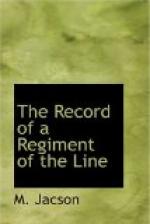In the dark of the morning, at three o’clock, General Kitchener set his column in motion: four companies, with a 12-pounder and two 5-inch guns, under Major Davies, preceded the force, with the intention of capturing the big Boer gun; four companies, with two field guns, under Captain Jacson, made a flanking movement through scrub and dongas round the left. Very little opposition was met with. The mounted troops captured a few prisoners, and it was found that the Boers had blown up their big gun. This was the gun that had been situated on Pepworth Hill, and which had been disabled by one of the Naval Brigade’s shells during the siege of Ladysmith. Its muzzle had been shortened, showing that it had been damaged. The Boers had blown the gun to pieces. The barrel of the gun was blown about fifty yards in front of the emplacement, whilst the breech-block was found afterwards 1-1/2 miles in rear. They had destroyed also one pompom and one Maxim. Twenty-eight Boers were captured, with about sixty head of cattle and thirteen wagons. The Australians had one man killed and one man wounded.
[Illustration: Remains of Boer Big Gun, Waterval]
The Waterval valley was well watered and exceedingly rich in crops, and the numerous farm-houses were full of families. These were collected afterwards by Colonel Park’s column and sent into Lydenburg.
On the 16th the column set out from Waterval in a north-westerly direction, the objective being Secoconi’s country and Magnet Heights. The first day found the force on the east bank of the Steelpoort River. The Dwars River, which was found in full flood owing to a very violent thunderstorm, had been forded on the way. The Regiment was rear-guard to the column, and, owing to delay in passing the baggage over the river, reached camp some considerable time after dark. The Australian mounted troops did not halt at the Steelpoort, but, fording the river, pushed on to Magnet Heights, which they occupied the same night. Park’s column had been in touch with Kitchener’s in the morning.
[Illustration: Crossing the Steelport River]
On the banks of the Dwars River Secoconi’s men were first met with. These, armed with rifles of various patterns ancient and modern, were out scouting for General Kitchener in all directions.
At dawn on April 17th the crossing of the Steelpoort River was commenced. One company of the Regiment was first sent across to occupy the high ground on the far side and to cover the crossing. The river was in flood owing to the heavy rain of the previous day, and the water above the men’s waist. The advanced company having got safely across and having occupied the high ground, the remainder of the infantry were sent over without casualty. The march was then continued towards Magnet Heights, which was reached at dusk. Here camp was formed, and on the following day the march was again resumed with mule transport only, through Secoconi’s land.




